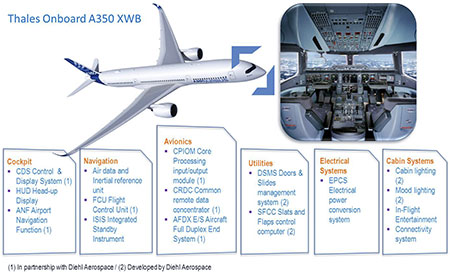
A comfortable, efficient cabin, five inches wider than 787
Over 70 percent of the A350 XWB’s weight-efficient airframe is made from advanced materials combining composites (53 %), titanium and advanced aluminium alloys. The aircraft’s innovative all-new Carbon Fibre Reinforced Plastic (CFRP) fuselage results in lower fuel burn (25 %better fuel efficiency) as well as easier maintenance.
Thales, an Airbus strong partner onboard A350 XWB
Thales is selected in 2008 to design and deliver avionics solutions for this new long range aircraft:
Interactive control and display system
Integrated modular avionics (IMA)
Air data and inertial reference unit
Electrical power conversion
Doors and slides management system and Slats and Flaps control computer developed by Diehl Aerospace
IFE (Inflight Entertainment) and connectivity systems (IFE&C)
This program is managed in Toulouse for avionics perimeter and involves all other French Thales Avionics entities: Meudon, Châtellerault, Bordeaux-Le Haillan, Vendôme et Valence.
Main events
January 2008: Thales is selected by Airbus on a large avionics shipset and for electrical power conversion
End of 2009: Thales starts to deliver the first IMA elements to Airbus and partners in charge of developing software functions
April 2010: Thales IFE is selected for the cabin
February 2012: 1st flight of an A380 with A350 XWB motors ; Thales is onboard with few equipments including the ADIRU
August 2012: Cockpit power-on
2nd half 2012: Thales delivers pieces of equipment ready for first flight
June 2013: A350 XWB first flight!
Thales technologies onboard

Displays and interactivity
With the advent of the A380 and now the A350 XWB, the main sea-change in the cockpit has been the shift to large display screens. Thales fits A380 cockpits with ten main screens, eight of which deal with avionics-related information, the remaining two being On-board Information System (OIS) displays, covering outside and open information relating to weather, traffic, etc.
The A350 XWB boasts an integrated system bringing together so-called “open world” and “closed world” (secure avionics) information, enabling the optimized management of information to allow the pilots to work efficiently together. For instance, they can bring information from the lateral screens to the central ones to allow them to work together on a particular piece of information.
With the new A350 XWB, if one of the screens fails, the cockpit displays are automatically reconfigured to use the lateral displays.
The new cockpit display system achieves simplified and streamlined interactivity with the entire system.
Overall, the A350 XWB cockpit has been designed as a natural evolution of the A380 cockpit, with the aim of ensuring continuity throughout the range. An A380 pilot will need just minimal amounts of training to be able to transfer to the new layout and functions of the A350 XWB.
Integrated Modular Avionics (IMA)
Thales’s Integrated Modular Avionics (IMA) solution represents a real-time airborne computer network system. This network consists of a number of computing modules capable of supporting numerous applications of differing criticality levels. The IMA is a major technical evolution of global importance for airlines and operators.
Using new technologies, Thales has standardized and reduced by half the number of CPIOMs (Core Processing Inputs/Outputs Module) and CRDCs (Common Remote Data Concentrator) – both of which are the main building blocks of the IMA suite – meaning that the components are easier to maintain, repair and stock.
The IMA represents a substantial leap along the path to standardization and simplification, and the whole aircraft is set to benefits.
Navigation systems
Thales has also implemented a new navigation system. The ADIRU (Air Data Inertial Reference Unit) defines the position of the plane with high precision and accuracy. While previously the aircraft’s position was calculated on the basis of the data from different systems, on the A350 XWB a single system will determine the position of the aircraft. Combined with a Flight Management System and OANS (Onboard Airport Navigation System), it will enable pilots to have the highest-possible precision guidance tools at their disposal.
These new technologies will enable the airlines to use SESAR new procedures (example: 4D trajectories) as soon as they will be available.
Head-up Display (HUD)*
Thales’ HUD is already available on all aircraft within the Airbus Fly-By-Wire family. A single or dual configuration will be available as a customer option in the A350 XWB catalogue.
New HUD provides a flexible platform for growth to support new features such as Enhanced Vision Systems (EVS) and potentially Surface Guidance System (SGS) and Synthetic Vision Systems (SVS), in addition to offering unique symbology entirely consistent with Airbus’ cockpit philosophy.
-----------------
*A head-up display is any transparent display that presents data without requiring users to look away from their usual viewpoints. The origin of the name stems from a pilot being able to view information with the head positioned "up" and looking forward, instead of angled down looking at lower instruments. Although they were initially developed for military aviation, HUDs are now used in commercial aircraft, automobiles, and other applications.



